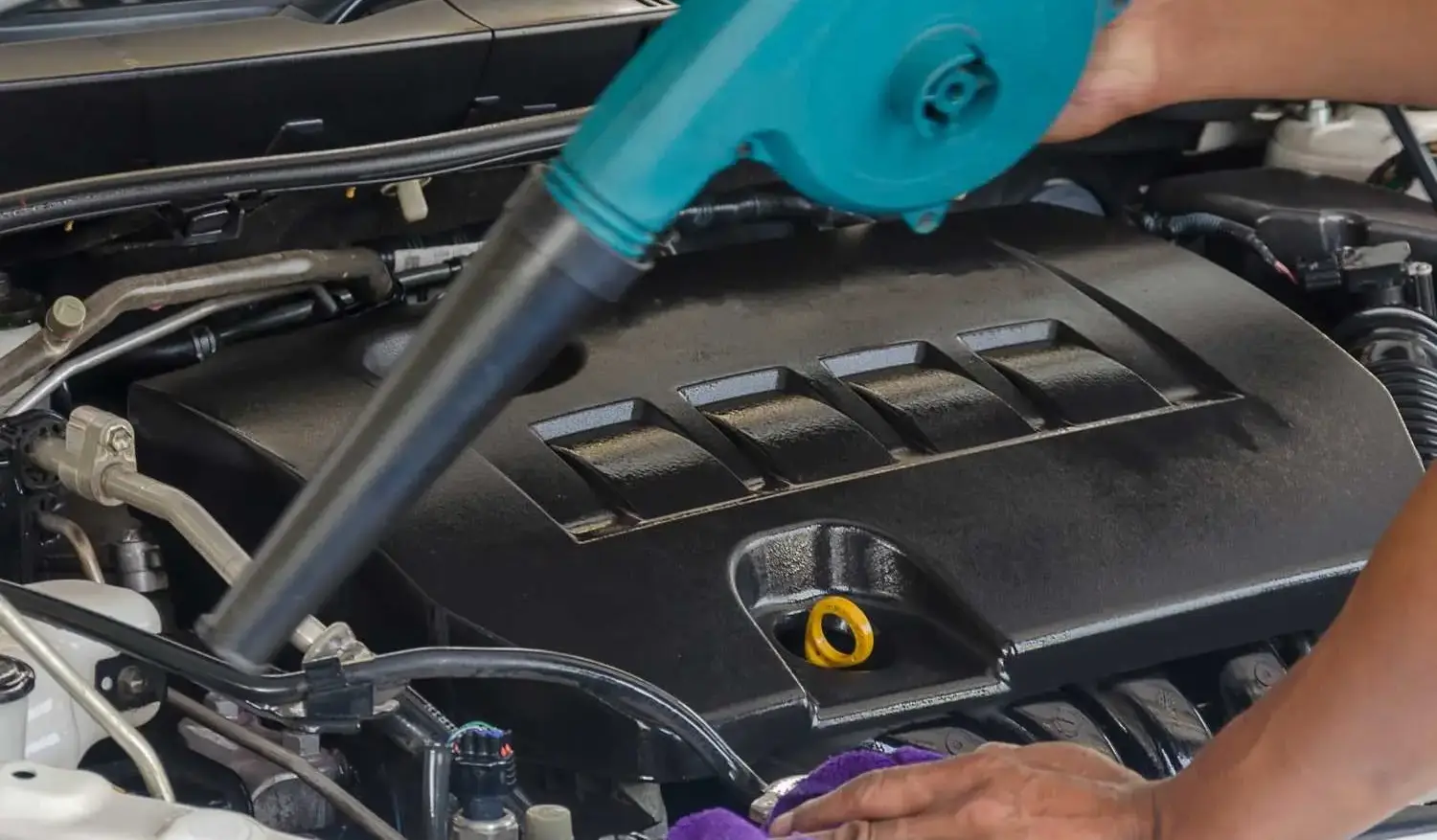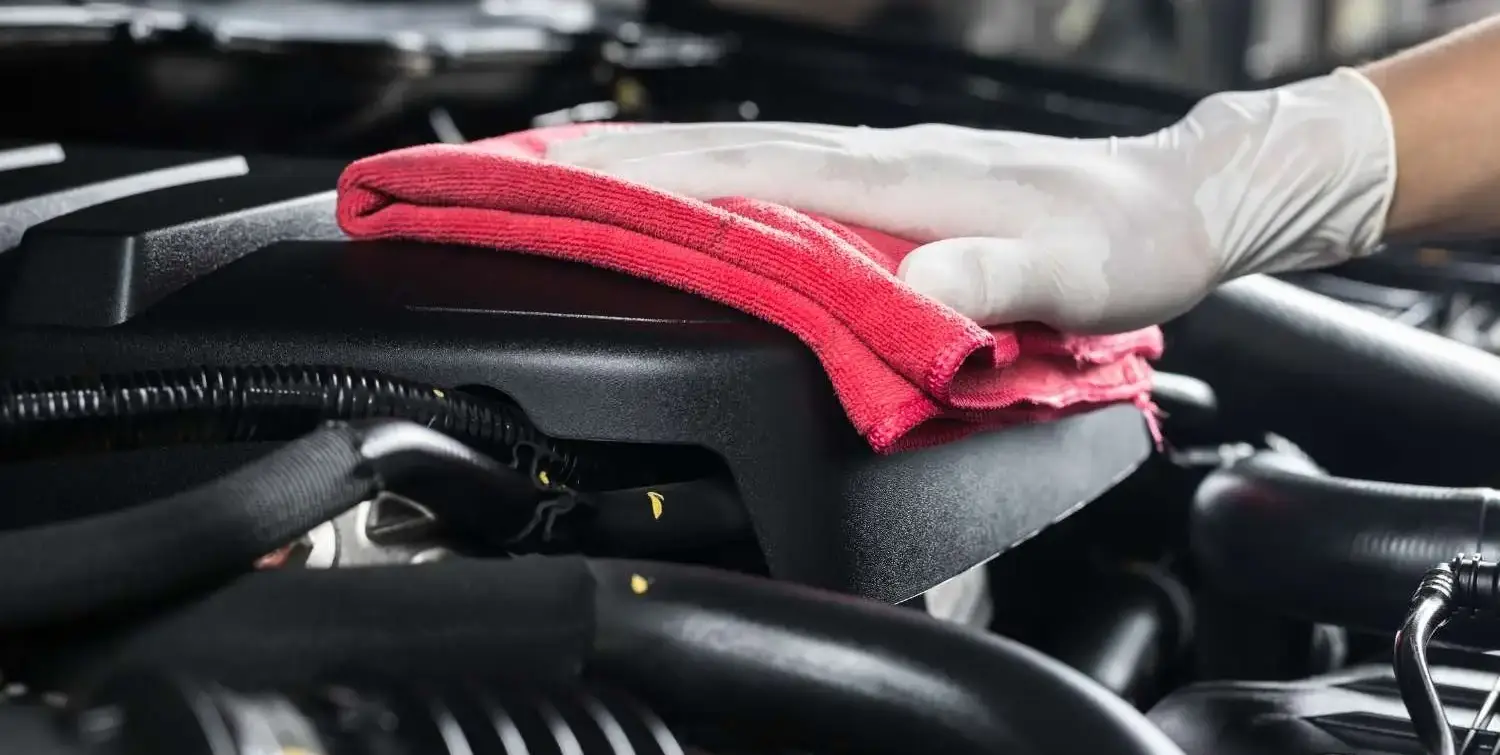While many can overlook the engine, understanding the importance of engine detailing is important to maintaining your car’s performance and longevity. Engine detailing makes your engine look good, and ensures your car runs as smooth as it should.
Over time, grime, dirt, and other contaminants can accumulate in your engine, affecting its performance. Regularly detailing your engine will give it a deep clean, removing harmful substances and preventing them from causing damage. This enhances your car’s performance and increases its lifespan.
Additionally, a clean engine is easier to work on and diagnose if problems arise. So don’t underestimate the value of a well-detailed engine.

How is an Engine Bay Cleaned?
-
Safety Preparations: Begin by disconnecting the battery to avoid any electrical issues. Cover all sensitive areas, such as electrical components and the alternator, with plastic bags or protective coverings to shield them from water and cleaning chemicals.
-
Degreasing: Using a degreaser or all-purpose cleaner (APC) spray it evenly across the entire engine bay, making sure to reach every corner and crevice.
-
Agitation: Use a detail brush to gently agitate the degreaser on the surface. This helps lift and break up oil, grime, and dirt buildup, making it easier to rinse away.
-
Rinsing: Carefully rinse the engine bay with water, ensuring all the degreaser and loosened dirt are washed away. Avoid direct water contact with sensitive components, even if they’re covered.
-
Drying: Thoroughly dry the engine bay using microfiber towels or compressed air. It’s important to remove all moisture to prevent electrical issues.
-
Protecting: Apply a water-based engine protectant or dressing. This adds a shine to your engine bay and provides a layer of protection against dirt, dust, and UV damage.
-
Final Steps: Once everything is dry and the protectant has been applied, remove the protective coverings from sensitive areas. Reconnect the battery, ensuring all connections are secure.
Gathering Necessary Tools
To begin the engine detailing process, ensure you have the following items ready:
-
Degreaser or All-Purpose Cleaner: Essential for breaking down dirt and oils.
-
Water-Based Engine Dressing: For a finishing touch that protects and shines.
-
Gloves: To protect your hands from chemicals and dirt.
-
Plastic Bags: To shield sensitive parts of the engine from water and cleaning agents.
-
Microfiber Towels: For effective scrubbing of grime and drying the engine after the detail.
-
Detailing Brush: To remove stubborn dirt in hard-to-reach areas.
-
Blower/Compressed Air: Used for removing any dirt or debris.
-
Pressure Washer or Pressurized Water Source: Crucial for a thorough rinse of the engine bay.
With these tools and supplies prepared, you’re set to detail your engine!
Preparing Your Engine
To start the engine detailing process, let the engine cool for at least 15 minutes, ensuring it’s safe to handle. This is an important step, as it prevents you from getting burnt and makes the engine safe to touch.
The preparation process of your engine is important for a successful detail. Here’s how to prepare your engine:
-
Disconnect the battery: To avoid short-circuiting the system, you’ll need to remove the negative terminal from the battery.
-
Cover sensitive areas: Electrical components are sensitive to water and can easily get damaged. Use plastic bags to cover areas like the alternator, or any visible wires and secure them with rubber bands or zip ties.
-
Remove any debris: Before you start applying any cleaning products, it’s essential to remove any visible debris. Use a brush or air blower to remove dirt and debris from the surface of the engine.

The Engine Cleaning Process
Step 1: Applying the Degreaser
Apply the degreaser or all purpose cleaner evenly across the engine bay. Ensure it reaches every nook and cranny, including crevices and hard-to-reach spots.
After the degreaser has been applied, allow it to dwell for a few minutes. The degreaser works by breaking down dirt, grime, and contaminants, preparing the engine for rinsing. Ensure your eyes and skin are protevted when using the degreaser.
Step 2: Scrubbing the Engine
Once the degreaser has dwelled for a few minutes, grab a detail brush to scrub the engine bay, focusing on areas with caked-on oil and dirt. This step is important as it agitates and loosens the stubborn grime that clings to your engine. Don’t be afraid to apply a little elbow grease thorough scrubbing ensures that every nook and cranny of your engine gets the attention it deserves.
After you’ve scrubbed every accessible part, rinse the engine bay. This washes away the loosened dirt and debris, leaving your engine looking much cleaner than before. Make sure you’re wearing protective clothing and eyewear during this process, as dirt and debris may splash about.
Here are a few additional tips to assist you in this process:
-
Don’t rush the scrubbing process, take your time to get into all the hard-to-reach areas.
-
Work in small sections to ensure you don’t miss any spots.
-
Always rinse the engine bay after scrubbing to wash away the loosened dirt.
-
Keep a microfiber cloth handy to wipe away excess water and avoid water spots.

Step 3: Using a Pressure Washer
After you’ve rinsed off the loosened dirt from the scrubbing stage, a pressure washer becomes your next best tool for a more thorough cleaning of your engine bay. The Pressure Washer works by providing a powerful stream of water, capable of reaching hidden parts of your engine bay. It’s the tool to effectively remove stubborn dirt, grime, and grease that you couldn’t get rid of during the scrubbing process.
But don’t just start blasting water everywhere. You’ll want to exercise caution when using a pressure washer. Directing its stream towards sensitive parts or electrical connections can lead to potential damage. Instead, keep a steady hand, a safe distance, and control your pressure washer’s aim to avoid potential issues.
Then, you need to ensure an adequate rinse. Use your pressure washer to thoroughly remove any leftover degreaser and residues. This is a critical step, as any leftover product can attract and hold dirt, defeating the purpose of your cleaning effort.
Using a pressure washer properly can make engine detailing quicker, more efficient, and a lot less labor-intensive. With a bit of practice, you’ll become a pro in no time.

Step 4: Wiping the Engine Dry
Upon completing the rinse with the pressure washer, grab a clean microfiber towel or use compressed air to thoroughly dry your engine. You want to make sure all the water and moisture are removed because any leftover could potentially cause issues with your engine’s electrical components. Pat and wipe down the engine bay gently to remove excess water in the engine bay.
To ensure you don’t overlook any spots, follow these guidelines:
-
Start from the top of the engine and work your way down. This method helps to avoid re-wetting areas you’ve already dried.
-
Pay careful attention to hard-to-reach areas and crevices. These places are notorious for trapping water.
-
If you’re using a towel, remember to swap to a clean and dry towel frequently. A saturated towel won’t absorb water effectively.
-
Don’t rush. Take your time to ensure everything is thoroughly dry.
Properly drying your engine bay not only prevents potential damage to electrical components, but also helps maintain the cleanliness and overall appearance of your engine.
Step 5: Applying Water Based Engine Dressing
With your engine thoroughly dried, the next step is to apply a water-based engine dressing to add shine and restore its appearance. This process enhances the appearance of your engine and forms a barrier against dirt, and grime.
Unlike traditional protectants, a water-based engine dressing offers a deep, rich shine without leaving a greasy residue, making your engine look brand new.
The application process is simple and effective. First, make sure the engine and its components are completely dry. Then, evenly spray the engine dressing across all surfaces of the engine bay, focusing on exposed areas. Finish by gently wiping away any excess product to ensure a uniform, glossy finish without any buildup. This step beautifies your engine and contributes to its long-term maintenance.

Maintaining a Clean Engine Bay
To keep your engine looking its best, it’s essential to maintain a clean engine bay. A clean engine looks good, and is easier to service. Here’s how you can keep your engine clean and in top shape.
-
Park in a garage or cover your car: This shields the engine bay from dirt and debris which can accumulate and cause problems down the line.
-
Wash your car regularly: This prevents the buildup of grime and contaminants in the engine bay.
-
Get professional detailing: Periodically, have your car detailed professionally. This ensures a thorough cleaning of the engine compartment that can’t be achieved at home.
-
Use mobile detailing services: For convenience and expert care, consider mobile detailing services. They come to you, saving you time and ensuring your engine bay is maintained.
FAQs
How Much Is an Engine Detail?
Engine detailing costs can vary. Typically, you’re looking at a range from $50 to $150. It’s best to check with your local providers to get the most accurate estimate for your engine’s needs.
Is It Safe to Detail Engine Bay?
Yes, it’s safe to detail your engine bay if done properly. Modern engines are designed to withstand cleaning. However, you must take caution. Avoid spraying water directly on electrical components to prevent causing damage. It’s crucial to cover sensitive areas before you start cleaning. Using appropriate techniques and products can ensure a safe engine detail.
Do I Need Engine Detailing?
Yes, you do need engine detailing. It’s about maintenance. A clean engine runs cooler, which improves its longevity. Plus, regular detailing allows you to spot potential problems before they get worse. It enhances your vehicle’s overall look and could even increase its resale value. You can either do it yourself or get a professional detailing service.
Final Thoughts
Cleaning your car’s engine bay is an essential part of car maintenance. By following the detailed steps and utilizing the recommended products, you can ensure that your engine bay looks good and is in pristine condition.



